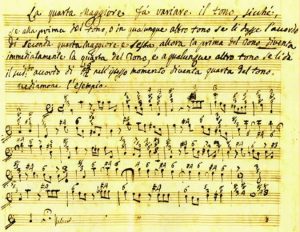Exploring Compositional Building Blocks and Musical Style Change with Hermeneutic and Computational Methods
This a three-year research project funded by the Volkswagen Foundation in the context of the “‘Mixed Methods’ in the Humanities” program (2018–2020). The PIs are Prof. Martin Rohrmeier and Dr. Markus Neuwirth. The project is carried out in cooperation with the Hochschule für Musik Freiburg (Prof. Felix Diergarten). Our national cooperation partner is the Schola Cantorum Basiliensis (Prof. Johannes Menke).
Project summary
It is one of the chief concerns of musicological scholarship to arrive at a better understanding of the principles and mechanisms underlying structure building in different musical styles. This issue has been addressed from such diverse disciplinary angles as music theory and analysis, historical hermeneutics, music cognition, and music informatics. The combination of these approaches, each having its unique historical tradition, within the field of digital humanities poses numerous methodological challenges, but also yields great potential for innovative forms of hermeneutic analysis of structure building and style change.
Since the last decade, voice-leading schemata have become a major topic, particularly for historically informed music theory and analysis. Voice-leading schemata may be regarded as central components of Western tonal music in the classical style and beyond. Based on the identification of patterns of schema usage, scholars can characterize musical styles and provide an explanatory framework for style change.
Considering these recent developments in musicological research, our proposed project encompasses three main objectives. Building on the current state of the art of musical schema theory we aim to achieve (1) a concise theoretical formalization of voice-leading schemata by drawing on insights from formal (computational) modeling approaches. Based on these conceptual refinements, we proceed to (2) the implementation of a computational model of voice-leading schemata that infers schemata from a given piece of music at the note level. The model will be evaluated with an annotated corpus of expert analyses. This ground truth corpus will be compiled from music-analytical sources and will be published over the course of the project. Building on this work, we will embed the schema model into a schema analysis and visualization tool (for online publication) that makes it possible to explore schemata in a given corpus from various viewpoints and statistical perspectives.
Using our computational framework, the project culminates (3) into the comparative exploration of characteristic patterns of schema usage across compositions and styles. This allows us to address hermeneutic questions of style description (including typicality and individuality) and style change across larger time spans on a broad repertoire basis, one that cannot be achieved by human hand-annotation. For this purpose, we will apply our schema exploration tool to a large corpus (already available) of pieces in MIDI and score representation from around 1700 to around 1970.
In pursuing these aims, we bring ideas from statistical and probabilistic modeling into music theory and historical musicology, and we will explore the potential benefits of combining hermeneutic and historical methods of understanding stylistic processes with corpus statistics. In so doing, our proposed project seeks to develop a comprehensive methodological framework that allows for a mutually fruitful interaction between two musicological subdisciplines that are usually seen to be divided by the humanities/science gap.
Publications
Neuwirth, M., Finkensiep, C., and Rohrmeier, M. (under review). “Musical Schemata: Modelling Challenges and Pattern Finding.” In Mixing Methods: An Agenda for the Humanities in the Digital Age. Edited by B. Löffler, B. Schneider, T. Mager, and C. Hein. Transcript: Bielefeld.
Finkensiep, C., Neuwirth, M., and Rohrmeier, M. (forthcoming). “Music Theory and Model-Driven Corpus Research.” In Oxford Handbook of Music and Corpus Studies. Edited by D. Shanahan, A. Burgoyne, and I. Quinn. New York: Oxford University Press.
Rohrmeier, M. and Neuwirth, M. (forthcoming). “Musikanalyse zwischen Theorie, Psychologie und Computation.” In Plurale Analyse – Methodenvielfalt in der Musikanalyse, 2 vols. Edited by O. Schwab-Felisch, J. Ph. Sprick, Chr. Thorau, and A. Jeßulat. Kassel: Bärenreiter.
Hentschel, J., Neuwirth, M., and Rohrmeier, M. (2021). “The Annotated Mozart Sonatas: Score, Harmony, and Cadence.” Transactions of the International Society for Music Information Retrieval 4/1, 67–80. DOI: http://doi.org/10.5334/tismir.63
Neuwirth, M. (2021). “Is There an Implicit Formenlehre in Fedele Fenaroli’s Solfeggi? Punctuation Schemes, Formal Functions, and Voice-leading Schemata.” In Neapolitan Musical Pedagogy of the Eighteenth Century: Theory, Sources and Reception. Edited by C. Bacciagaluppi and M. Laterza. Bern: Lang, 47–77. DOI: https://doi.org/10.3726/b18803
Finkensiep, C., Déguernel, K., Neuwirth, M., and Rohrmeier, M. (2020). “Voice-Leading Schema Recognition Using Rhythm and Pitch Features.” Proceedings of the 21st International Society for Music Information Retrieval (ISMIR). Montréal, Canada 2020, 520–526. DOI: https://doi.org/10.5281/zenodo.4245482
Wall, L., Lieck, R., Neuwirth, M., and Rohrmeier, M. (2020). “The Impact of Voice Leading and Harmony on Musical Expectancy.” Scientific Reports 10/1, 1–8. DOI: https://doi.org/10.1038/s41598-020-61645-4
Neuwirth, M. (2019). “Mittelzäsur oder förmliche Cadenz? Das Problem des mehrfachen Schließens in den Sonatenexpositionen Haydns, Kozeluchs und Pleyels.” In Schließen – Enden – Aufhören: Musikalische Schlussgestaltung als Problem in der Musikgeschichte. Edited by F. Kraemer and S. Wegner. Munich: edition text+kritik, 160–188.
Finkensiep, C., Neuwirth, M., and Rohrmeier, M. (2018). “Generalized Skipgrams for Pattern Discovery in Polyphonic Streams.” In Proceedings of the 19th International Society for Music Information Retrieval Conference (ISMIR), Paris 2018. Ed. E. Benetos, E. Gómez, X. Hu, and E. Humphrey, 547-553. DOI: https://doi.org/10.5281/zenodo.1492473
Neuwirth, M. (2015). “Is There a ‘Musical Task’ in the First Movement of Haydn’s ‘Oxford’ Symphony? Voice-leading Schemata and Intrinsic Formal Functions.” Music Theory and Analysis 2/2, 194-203. DOI: https://doi.org/10.11116/MTA.2.2.3
